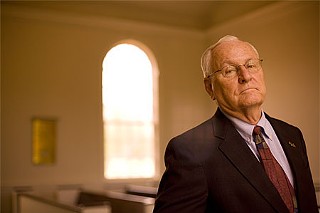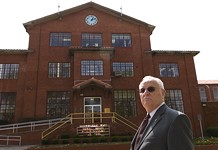TV Eye
Crime and Punishment
By Belinda Acosta, Fri., May 23, 2008
Death and dying has a high profile in popular culture. On TV, the subject is often seen through a soft lens, with the dearly departed coming back to offer words of wisdom or to share last words with their loved ones (as in Ghost Whisperer on CBS) or demanding that the truth of their deaths be revealed (as in Medium on NBC). Foremost behind these series is a desire for justice to prevail, for wrongs to be righted, and, for audiences, to have some large message from a higher power revealed. Death on TV is like funerals – melancholic and always made pretty for the living. So it's something of a shock to experience it at its worst: purposefully, methodically, under the guise of justice. This is what drives the newest film by Steve James and Peter Gilbert, At the Death House Door, which premieres on IFC next week.
Shown earlier this year at South by Southwest, the documentary is from the award-winning filmmakers of Hoop Dreams. The film explores the death penalty through three angles: the Rev. Carroll Pickett, the former "death house chaplain" at the Huntsville Penitentiary, whose job, as one warden put it to him, was to "seduce [prisoners'] emotions during the day so they would not try to fight at midnight"; Carlos De Luna, executed in 1989 for a murder he didn't commit; and Chicago Tribune reporters Steve Mills and Maury Possley, who wrote about the De Luna case. It was their investigative reporting that brought De Luna's story, and the story of a failed justice system, into glaring light. But at the center of At the Death House Door is Pickett. A soft-spoken man with a sturdy demeanor, he tells his story in an evenhanded manner that is as tender as it is startling. It turns out Pickett made tape recordings following each of the executions he witnessed (95 in all), documenting what he saw and felt, what the prisoners said or didn't say (including two mentally challenged prisoners who requested their colors and coloring books), and most of all, what it meant to be with someone on the day they knew they were going to die.
Early in his life, Pickett supported capital punishment. His grandfather had been murdered, and his father – who was a boy when his father (Pickett's grandfather) was killed – never overcame that bitter loss, becoming an emotionally distant parent who believed that there was no mercy for murderers, that sparing the rod would spoil the child, and that boys shouldn't cry under any circumstances. Pickett's position on the death penalty was only made stronger in 1974, when two of his parishioners were killed during the 1974 inmate siege of the Walls Unit at Huntsville (which later became known as the longest prisoner siege in U.S. history). The experience was devastating, and he vowed never to enter the prison again, but that's not what fate had in store for him. He took the job as prison chaplain with his opinion about the death penalty deeply entrenched. Yet, over time, after dozens of executions, Pickett was probably the most surprised to see his stance change. It was the De Luna case that was the final straw, and it's De Luna's case that will forever haunt him.
While the film falls on the anti-death-penalty side, it does so without chest-beating (though the background music is a bit heavy-handed). What makes it truly remarkable is that it manages to answer the provocative question from the pro-capital-punishment faction – what would you want to happen to the animal who raped and murdered your mother/sister/wife? – with a more expansive and provocative question: Do you want to become the thing you hate?
The premiere of At the Death House Door is timely. After a seven-month moratorium on executions, the state of Texas will resume the practice June 3. Derrick Sonnier is scheduled for execution in Huntsville, and 10 executions are already planned for the coming year. The Sonnier execution is the first since Texas Court of Criminal Appeals Judge Sharon Keller refused to accept an appeal for an execution set to occur that evening because, in her words, "We close at 5," and the appeal came 20 minutes too late.
Die-hard death penalty supporters may not change their position after watching At the Death House Door, but it will surely leave a lasting, troubling impression – which is probably the best thing any work of art can hope to do.
At the Death House Door airs Thursday, May 29, at 8pm on IFC.
As always, stay tuned.










